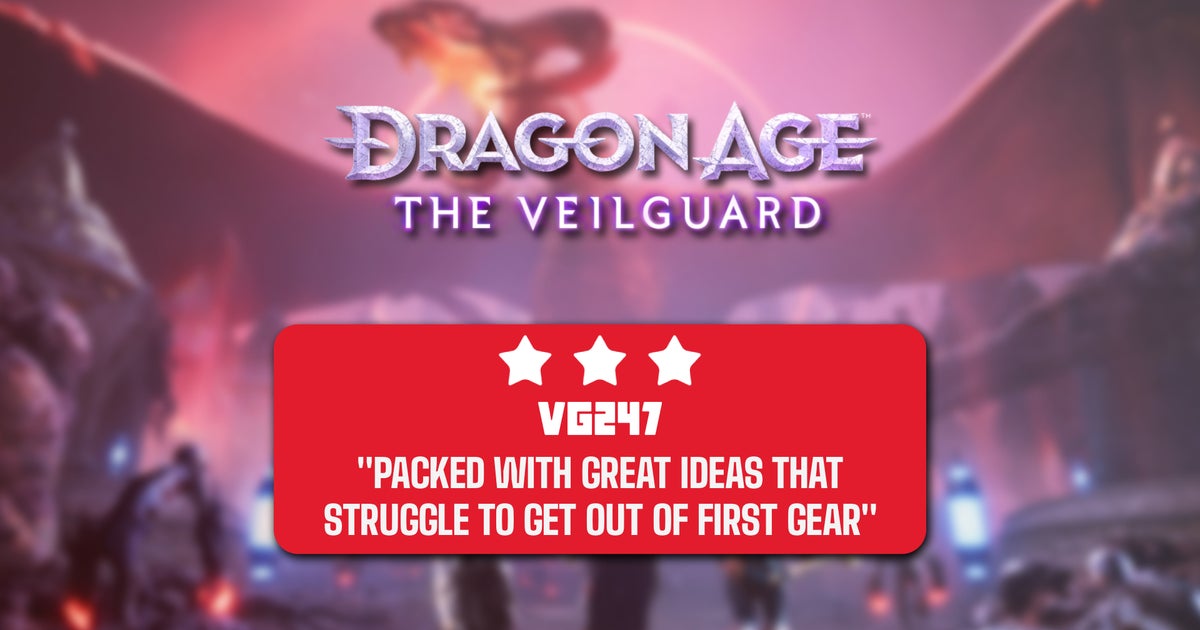Dragon Age: The Veilguard features one of the most intricate, interesting, and exciting skill systems I’ve seen deployed in an action-driven RPG in years. Its character progression threads the needle better than most of its rivals, offering up a depth of progression with game-breaking potential that’s meant to evoke the feeling of the enormous options found in the crunchy numbers-led ‘CRPGs’ of old.
But then the game hits a bit of a snag: it’s breezy and casual, and even on harder difficulties it doesn’t feel like there’s too much incentive to fully engage with its role-playing depth unless you simply do it for the sake of it ‘cos that scratches an itch. This feels like a problem.
I open with this because I feel it acts as a potent summary of what the fourth full entry in the Dragon Age series does best and worst all at once. This is a proficient, polished game with certain mechanics and ideas that threaten to be best-in-class. In a certain sense, this game has it all – but that all doesn’t quite coalesce in the way I’d hoped, which leaves features that are deep on paper feeling shallow. It’s a head-scratching conundrum.
A lot of what Dragon Age: The Veilguard is can be best expressed by outlining its structure. In short, much of the setup here is lifted from the second and third Mass Effect titles as a base, with the icing concepts lifted from other Dragon Age entries. There’s a hub zone where you can prep for missions and hang out with your party members, open-ended zones where you can shop, hang out, and trigger side quests (that somehow feel like a small slice of an Inquisition zone), and story-driven missions that are more directed and prescribed, each a lively but enclosed roller coaster. Usually, a couple of these missions pop into your journal in each chapter – meaning you have a choice of which to tackle first.
This is quite a break from Dragon Age: Inquisition, the last title in the series. That was a full-on open world affair, and was arguably too big. The stripped-back approach here might ruffle some feathers as a regression, but here’s the thing: it bloody well works. Those games I reference came out well over a decade ago, but there’s an element of ‘if it ain’t broke, don’t fix it’ at play here – it’s compelling, and it works. Perhaps most importantly it’s a structure that BioWare implicitly understands, because the studio essentially invented it. After the misfires of Andromeda and Anthem, this feels like a return home, with all the comfort that bequeaths.

Since the first title, Dragon Age has muddled around, experimenting with different battle formats. The Veilguard also draws from Mass Effect here: single character control, with snappy action combat and the ability to order companions to use special attacks that can combo together to devastating effect. Swap out the third-person shooting of ME2 & ME3 for snappy melee action and you’ve got this game, basically. Strangely, however, I felt this game always felt best when I stood back, as a rogue, and used my bow. But it was still plenty satisfying up-close, for the most part.
With the practised strength of this cadence and setup, an awful lot of Veilguard works. I enjoy the cast of characters quite a lot; the call-backs to previous Dragon Age stories and crews never fail to delight. But like that brilliant skill system that’s matched with an enemy spread and encounter design that doesn’t leverage its depth nearly enough, it feels like there’s always some nasty caveat lurking in some darkened corner. It’s rarely something big, either – it’s almost always something little. But to some extent, it’s the little things that make up life – and great games.
That 2012-era structure feels to creak, for instance, when you look at the design and structure of some of those linear levels. In the review period, I heard another critic describe them as “Overwatch maps” – and I think that’s a little harsh and hyperbolic, but I hold up the point with nary an objection. They almost universally feel rather boring. As well as combat encounters, puzzles dot these missions and maps – but quickly you realise that it’s going to be the same two or three formats of power cell, blight-clearing or beam-pointing challenges over and over again. As stuff like this settled in, a real enthusiasm I had for the adventures of The Veilguard over the first ten or so hours began to dull.
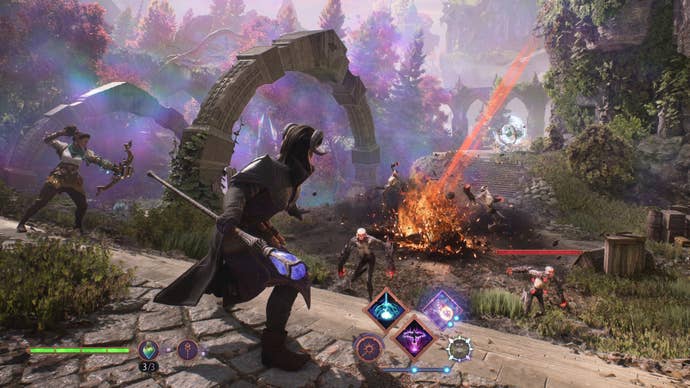
Any good RPG has side quests, so let’s slip one into this review, too. I’m about to zoom into one specific and likely esoteric complaint that I nevertheless feel demonstrates something of what makes some of The Veilguard feel strangely off.
There are beggars everywhere in the towns of this game. Likewise, there are cats and dogs. You can chip a coin or two to the beggars, and in search of viral gold, you can pet the furry friends. But there’s a strange fact to these interactions – they don’t really do anything. I’m not saying every feature must have mad consequences; not everything must lead to a quest or what have you – but I mean that in my experience, this action appears to do nothing.
The beggars and dogs in particular react so little that I genuinely wondered if I had a bug where a reactive animation was failing to play – but other critics tell me they experienced the same. The cats would at least purr, the sound effect accompanied by a delightful controller rumble – but this is weird, right? You don’t even get the satisfaction of a wagging tail and a spin of excitement, or a wave of thank you. Dogs lay there looking half dead. Your player character tosses a coin or rubs a hand into fur, and… that’s it. On one occasion, a companion had a line of dialogue addressing one beggar, but I couldn’t actually figure out if this was random ambient dialogue or triggered by my action. This disconnect is amusingly underlined by how you can give coins to beggars even with zero gold in your inventory – because it’s just a one-way animation, and has nothing to do with your actual character’s status.
You might think this is a ridiculous thing to deep-dive into in a review (we’re on three paragraphs about this now, oh god) but it speaks to something about The Veilguard’s approach to design. We are a million miles away from where these games were a digital facsimile of Dungeons & Dragons. A DM would have the beggar respond, and wouldn’t let you tip invisible, non-existent gold. These animations are nice-to-have on paper… but in reality, these actions present such a fragile veneer of role-playing that it ultimately takes me out of the experience.
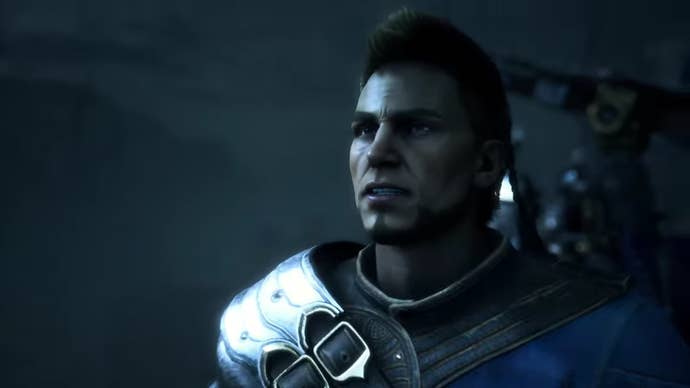
The worst thing, I think, is that as I previously said, I found the game to be full of these sorts of little things. It’s frustrating and whiplash-inducing because so much of The Veilguard shows such immense potential. It’s a game brimming with heart, and energy, and good ideas – but many of them feel like they struggle to reach full potential in execution. Giving a few coins to a beggar is a worthy, wonderful character role-playing beat – but here, with such a flat reaction as to be invisible, it barely registers. These things are tiny, but it’s death by a thousand cuts; I felt that little disappointments like this stacked up with alarming regularity.
And yet, with all these disappointments explained and acknowledged – there’s a ton to love in this game. Like I say, the cast works. I think Harding, in particular, is utterly wonderful. I became quite attached to my lovely, northern-accented protagonist Rook, who I also think might be one of the best iterations of a player-insert protagonist BioWare has managed.
The decision to switch back to a more simple conversation system is smart. For the most part, you’re now choosing how to say the thing Rook is about to say, rather than what to say. The base three options always boil down as Nice, Tough, and Funny – but occasionally other threads appear, too. This means you’re less often making decisions that branch quests, but more making role-playing decisions about what sort of person your Rook is. It’s a smart play, bolstered by the fact that while in many cases all three or four answers to a particular dialogue might involve Rook ultimately saying ‘yes’, the choice of tone can pivot the entire rest of the exchange as characters react with unique responses. I really like this; it feels meaningful, something which isn’t true of all other mechanics.
For those craving world-altering decisions, every now and then that desire will be placated with harsh A/B choices of what to do, who to help, or where to save – and the consequences of these moments are often more satisfyingly nuanced than they first appear. To some degree these channel Mass Effect’s best-ever choice, the binary can’t-win pick-one moment on Virmire. I like that.
I love the animation for Rook opening significant chests, which has the snappy and stylistic showiness of a gacha loot box. While it led to cries of “hero shooter” – meant as a pejorative – when the game was revealed, I think the less-realistic, more stylized character designs are beautiful and expressive both. All of this dovetails nicely: the story, once it ramps up, is up there with the skill system as one of my favourite pieces of this game. Additionally, the entire narrative framework works hard to ensure this is one of the most inclusive role-playing games ever made: a total and welcome success.
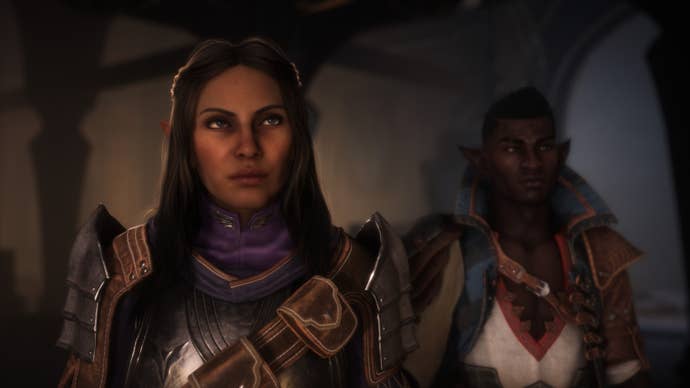
As an RPG nerd, I’ve enthusiastically talked up the skill system before, both earlier in this review and at preview. But in the final game I can also say I enjoy the gear system, particularly how obtaining duplicates powers up the existing gear you own – an elegant solution. I also think the truncated skill trees of companions, tied to a generic ‘bond’ level that’s pushed higher by both friendship and combat, is the best middle-ground version of companion progression BioWare has offered to date.
As you can see, there’s smooth to go with the rough. Where there is rough, it’s more in subjective design decisions than in the objective. Nothing is broken, mercifully. This is not the unpolished mess that BioWare has delivered under duress in the past; in fact, it might be their most polished game ever. The PC version is one of the best day-one PC versions I’ve seen.
It’s worth noting that there’s one thing I love about this game that I expect will be a common complaint among those who like it less: it’s a really video gamey video game. Sometimes games like this feel like that almost by mistake – but here it’s worn with a badge of honour, in a sense. When you come across one of those blight puzzles, it’s got a content-padding, ‘this is gameplay’ feel to it that isn’t as common now as it was twenty years ago. This is a puzzle, yeah? It’s meant to stop you from rattling through the content too quickly, y’know? Get on with it! When you combine this with the familiar structure, this feels like the most beautiful, most ambitious, and most rich game out of 2010 or so you can possibly imagine. For some that’s going to be bad; for me, as someone who really likes that era, I enjoyed it.
But then I’m back and forth, like that Curb clip of an indecisive, grimacing Larry David, which became a wonderful giffable meme. I think about how much I enjoyed the finale, which pulls every satisfying climax string BioWare learned with Mass Effect 2 and 3 in particular (let’s just say both companion emotional state & strength of allied factions both play a role) and I utterly grin. I think about the predictable structure throughout and I grimace. I think about how much I love that skill system and I beam – it’s real RPG nerd stuff. But then I remember frustrating combat encounters made worse by poor gameplay readability, and a world that beyond the characters doesn’t feel very alive and I… Well, yeah. I’m pulling that Larry face again.
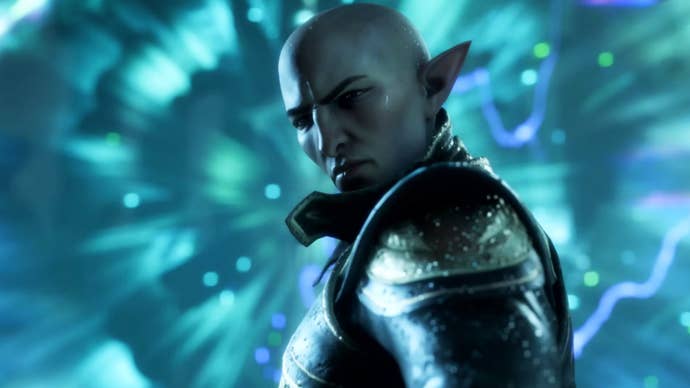
At the centre of the plot of Dragon Age: The Veilguard is Solas, the Dread Wolf. A party member in Inquisition, Solas finds himself in a curious position in this game. The player is asked to draw their own conclusion about him; is he evil, or a misguided antihero? The truth, of course, is not so black and white. In a sense, Solas himself becomes an emblem for this game that is so much about him.
Like the Dread Wolf, Dragon Age: The Veilguard is likely to be divisive. Some are inevitably going to view it as a heroic homecoming for BioWare, an example of the studio playing its greatest hits while gingerly treading into new areas. Others will inevitably dislike the choices made – half of this, part of that – never, arguably, forming a truly cohesive whole. Me? I fall somewhere in the middle, on Solas and the game alike.
Dragon Age: The Veilguard is full of heart and soul. It’s also got some great ideas. Conversely, many of those ideas feel like they struggle to get out of first gear – and those that do find it harder still to make it to third. Sometimes the cleverest ideas are undermined by other systems or decisions. Simultaneously feeling polished to within an inch of its life in places and utterly half-baked in others, it’s as baffling as it is engaging; as frustrating as it is fascinating.
I expect the divided discourse to be as interesting as – and more varied than – the game. One thing that I think is inarguable, though, is that it showcases a BioWare on steadier feet than at any point in the last decade. Where that firmer stance has been planted just means one’s mileage really is going to vary more than the norm, depending on your predilections and tolerances.
Dragon Age: The Veilguard launches October 31 for Xbox Series X/S, PS5, and PC. This review is written based on PC code provided by the publisher.

